Instruments
Presented by Octagon at eyes never sleep
September 19, 2021-October 31, 2021
![]() Installation view of American Coinage and Pointing Machine (Macchinetta di Punta)
Installation view of American Coinage and Pointing Machine (Macchinetta di Punta)
![]()
Installation view of Dross and Surmoulage
![]()
Installation view of Billet (Copper) and Consignment, Ormolu and Blue Glass Centerpiece with Floral Arrangement
![]()
1. Pointing Machine (Macchinetta di Punta)
Cooper Campbell
With assistance from Richard Zeeme
After John Bacon the Elder RA, Antonio Canova, Nicholas-
Marie Gatteaux
Late 18th Century/2018-2020
Brass, steel
Dimensions variable, est. 24”, 18”, 12
Price extrapolated from labor hours.
By the late eighteenth century the classic sculptor of high fame, whose mind must necessarily be engaged upon his designs in clay or wax, employed assistants to give permanence to his oeuvre. Sculptors of this type were so persuaded of their genius that they expressed some condescension towards those craftsmen upon whom they were now dependent.1
A Pointing Machine is a device used to fabricate one-to-one copies of existent sculptures in subtractive materials (stone, wood, plaster, etc). The device describes the three-dimensional form of a work by measuring points along its surface in relation to each other. The ability to precisely measure and transfer three-dimensional forms allowed the sculptor to contract the labor of production to unskilled or less skilled craftsmen. Three primary needles allow a carver to establish a fixed position on the work they wish to copy and the material they wish to copy the work onto. From this fixed position the carver may create exact measurements of the form using a fourth needle seated in a spring loaded saddle at the end of an articulated arm. The sculptor thereby transfers the spatial data of a pre-existing form onto a new block of material to a high degree of precision.
Evidence of the employment of primitive versions of the pointing machine have been observed in Greek and Roman sculptural practice. However, the earliest known example of a modern Pointing Machine was produced by the French Medalist Nicholas-Marie Gatteaux (1751-1832) sometime in the late 1700’s though the English Sculpture and Porcelain manufacturer John Bacon (1740-1799) produced a similar device in the same era that he later gifted to the Italian artist Antonio Canova (1757-1822) who perfected the device and popularized its usage.
![]()
2. American Coinage
Cooper Campbell with Thomas Lunt
1860-1978/2020
Carboard, copper, gold, silver, steel
Dimensions variable
Available for lease with monthly rental cost contingent on
face value, material value (as per COMEX) and numismatic
value (as per Greysheet) appraisals. Contract available upon
request.
There are three primary forms of money. Commodity money has inherent value such as salt, cocoa beans, and tobacco or the exchange of precious metals like gold, silver, and copper. Representative currency functions as a certificate, its value being generated by its function as a guarantee of a predetermined amount of a select commodity. The third form is called fiat currency, money whose value is expressed through social agreement.
The coins in American Coinage are all examples of partially representative money, these coins (save for a limited pressing of steel pennies issued during a copper scarcity caused by WWII) are all partial commodity tokens. The face value or intended value of the coins is divorced from their material commodity value via the decoupling of US’s dollar from the gold standard. Additionally the influence of perceived scarcity has distorted the value of these coins, creating a third form of numismatic value or collectability. There is no static value for these coins due to the fluctuations of the value of the dollar, the precious metals markets, and the numismatic markets. All continually reappraise the value of these coins.
![]()
3. Surmoulage
Cooper Campbell, with assistance from Firebird Bronze
Foundry, Portland OR.
After Auguste Rodin with Rudier Foundry, Sculptures LTD.
1897, 1965-1975 (approx), 2020
Bronze
12 x 6 x 8 inches
Editon of 12 with 2 Artist’s Proofs
Price contingent on market rate.
The work is a surmoulage1 of Rodin’s Definitive Study for the Head of Balzac, (1897). Surmoulage is reproduced from a resin edition produced by Sculptures LTD a company that specialized in low cost resin editions of minor works by canonical Western artists.
This casting is not a true edition. Despite the casting having Rodin’s signature as well as the foundry mark from the artist’s lifetime foundry2, leaving the sprue system attached and the bronze un-patinated disallows the intended authorship of Rodin while still retaining the form of the intended work.3
The original work Definitive Study for the Head of Balzac, (1897) by Auguste Rodin is a study for the Monument to Balzac (1891–1897), a public commission from Société des Gens de Lettres de France. Following the initial display in 1898 at the Salon at Champ de Mars, the work was rejected by the Société and the plaster was moved to Rodin’s studio at Meudon where it was displayed for the next forty years before being editioned in bronze in 1939, twenty-two years after the artist’s death.
Often referred to as the first modern sculpture, monumental bronze castings can be found in the collections of The Norton Simon Museum of Art (Pasadena, California, U.S.), the Hirshhorn Museum Sculpture Garden (Washington D.C, U.S.), the Museum of Modern Art in (New York City, New York, U.S.), the Los Angeles County Museum of Art, (Los Angeles, California, U.S.), the Middelheim Open Air Sculpture Museum (Antwerp, Belgium), the Musée Rodin (Meudon, France), the Van Abbemuseum (Eindhoven, Netherlands), Hakone Open-Air Museum (Ashigarashimo District, Kanagawa Prefecture, Japan), the National Gallery of Victoria in (Melbourne, Australia), and in public installation at the intersection between Boulevard Raspail and Boulevard du Montparnasse, (Paris, France) as well as in the open spaces around the former Ateneo de Caracas (Caracas, Venezuela). Evidence suggests two additional castings; one somewhere in the U.S. and another in Europe.
Bronze editions of Definitive Study for the Head of Balzac (1897) were initially cast by Georges Rudier nearly fifty years after Rodin’s death, from the plaster studies made in preparation for the monument and left behind in the artist’s studio. The study can be found at the Musée Rodin (Meudon, France) with editions found in the collections of Cleveland Museum of Art (Cleveland, Ohio, U.S.), Baltimore Museum of Art (Boston, Massachusetts, U.S.), Chrysler Museum of Art (Norfolk, Virgina, U.S.), Legion of Honor (San Francisco, California, U.S.), Mount Holyoke College Art Museum, (South Hadley, Massachusetts, U.S.), The Hirschorn, (Washington, D.C., U.S.), The Kreeger Museum (Washington, D.C., U.S., two copies in the National Gallery of Art (Washington, D.C., U.S.), Maryhill Museum of Art (Goldendale, Oregon, U.S.), the Brooklyn Museum (New York City, New York, U.S.), McMullen Museum of Art at Boston College (Boston, Massachusetts, U.S.), The Museum of Modern Art, (New York City, New York, U.S.) as well as a plaster at the Nasher Sculpture Center (Dallas, Texas, U.S.).
![]()
4. Dross
Cooper Campbell
2020
Bronze, Unknown Heavy Metals
9”, 9”, 6”
Price contingent on copper spot price appraisal (as per
COMEX).
Dross is the term for material impurities of a given alloy or metal that has formed on the surface of liquid metal during the casting process. They are primarily oxides that are produced by the extreme heat necessary for the casting process—as well as tertiary contaminants that may exist in the casting stock.
Dross is absolute waste. Due to its unreliable and unknown make up it is unusable in any continued casting process and unrecyclable as a byproduct. The work is a concretion of this cast off and waste materials bound into a consolidated mass by a matrix of bronze.
![]()
5. Consignment; Ormolu and Blue Glass Centerpiece with
Floral Arrangement
Louis Constant Sévin for the Barbedienne Foundry, Cooper
Campbell, Consigned by Colin Ross, Flowers from Saffron;
Arranged by Grayson Scott
1880, 2021
Cobalt Glass, Ormolu Bronze (Gold), Flowers
Ormolu and Blue Glass Centerpiece available via M&M
Gallery. Foral Arrangment COA available via Colin Ross with
proof of purchase of Ormolu and Blue Glass Centerpiece.
Price contingent on market rate.
An ormolu bronze vase1, decorated with medallions of putti and trophies of musical instruments lined with cobalt blue glass, designed by Louis Constant Sévin2 for the Barbedienne Foundry3, cast 1880, Paris. Consigned to gallery eyes never sleep, LLC from the New York City antiques dealer M&M Gallery for the exhibition. The vase features a bouquet of primarily French flora: White Gentian, Chamomile, Heather, Paper Reed and various American Grasses arranged by florist Grayson Scott. The bouquet will remain in the vase for the duration of the consignment.
![]()
6. Billet (Copper)
Cooper Campbell with assistance from Michale Carbone and
Ha-Lan Van
2020
Copper
3”, 3”, 34”
Available by lease with monthly rental cost contingent on
copper spot price appraisal (as per COMEX).
Copper can first observed in the material record of humanity roughly 8,700 BCE the first known example of human manipulation of this metal (or any metal) being a small pendant found in what is now Northern Iraq1 that appears to be hammered out of “native copper” or naturally occurring deposits of relatively pure copper metal.
Additional examples of decorative objects wrought from native copper have been found in Cyprus, Northern Iran2 and Michigan’s Upper Peninsula3 both dating back to roughly 7000 BCE. Over the course of the intervening millenia Copper has been one of the most instrumental materials in human technological advancement; first used as decorative objects (Like the Iraqi pendant) that dually functioned as currency, copper was quickly utilized in tooling before being retasked during the industrial revolution as electrical wiring–its ductility and conductivity allowing for the electrification of modern society. Cast from both industrial and domestic scrap material (electrical wiring, plumbing line and fittings, electric motor windings, computer parts, decorative figurines, american pennies, etc) purchased from Steve Cook at spot price per pound the material present in Billet (Copper) was cleaned and partially refined before being cast and machined down a billet weighing exactly one-hundred pounds.
Presented by Octagon at eyes never sleep
September 19, 2021-October 31, 2021
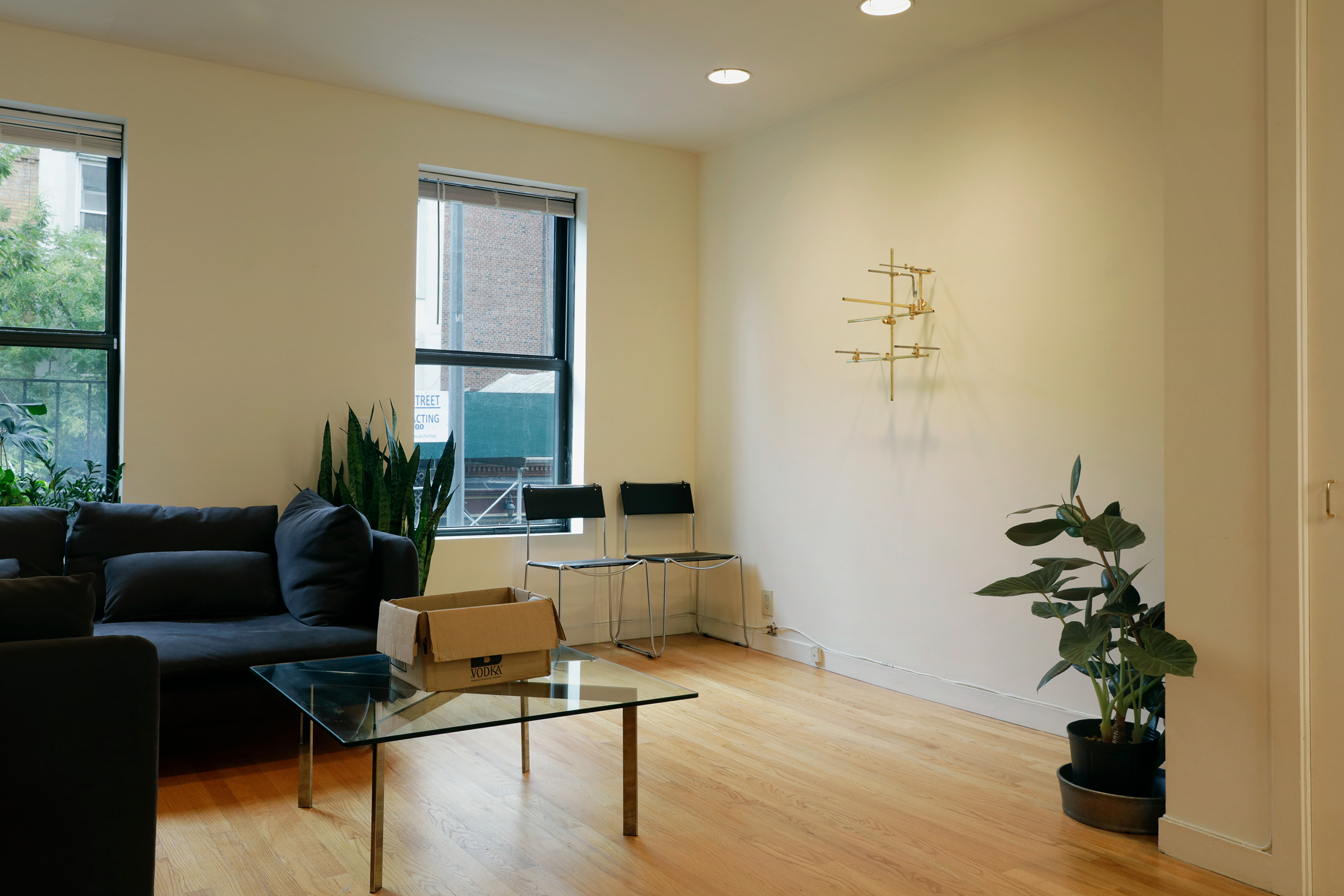 Installation view of American Coinage and Pointing Machine (Macchinetta di Punta)
Installation view of American Coinage and Pointing Machine (Macchinetta di Punta)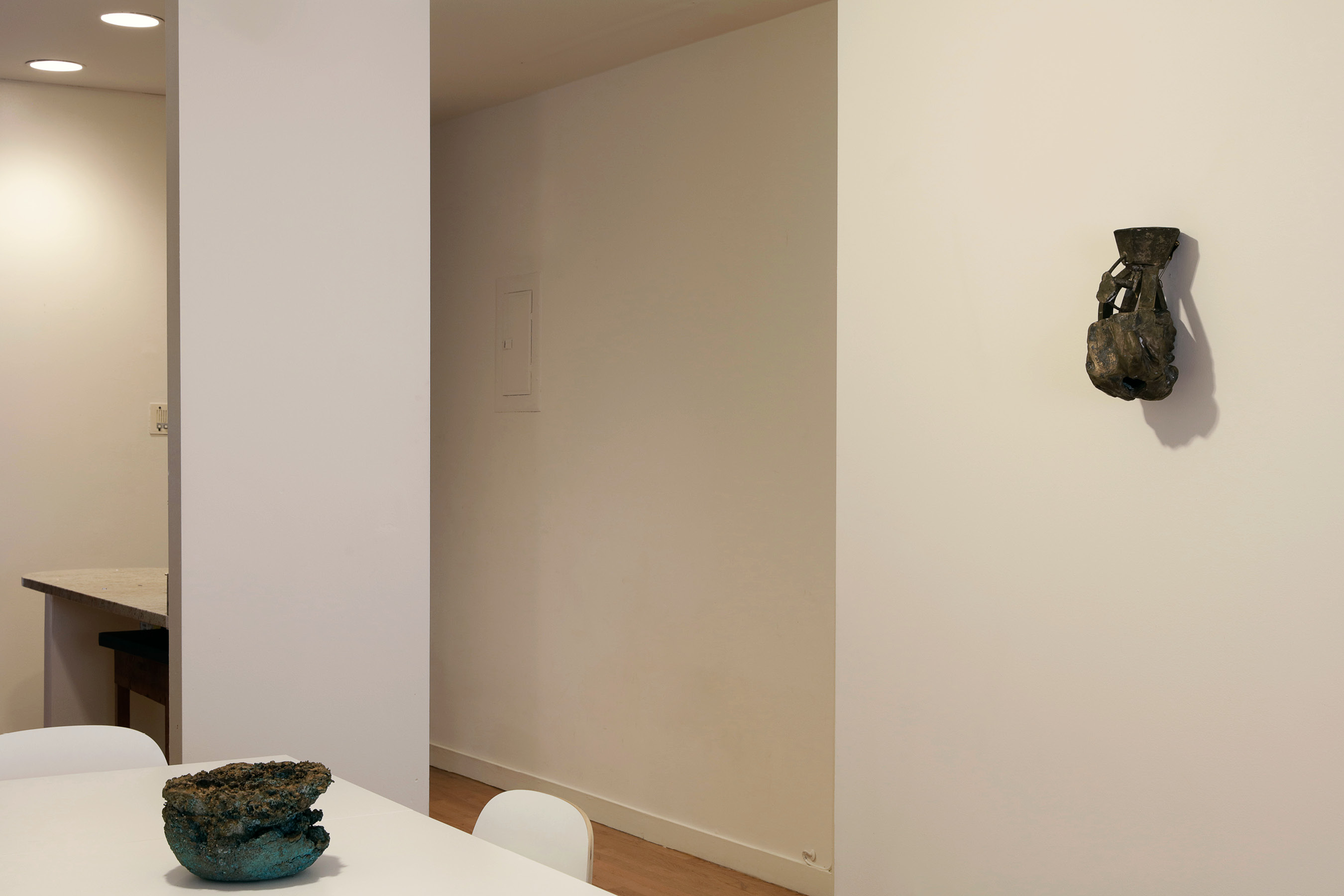
Installation view of Dross and Surmoulage

Installation view of Billet (Copper) and Consignment, Ormolu and Blue Glass Centerpiece with Floral Arrangement
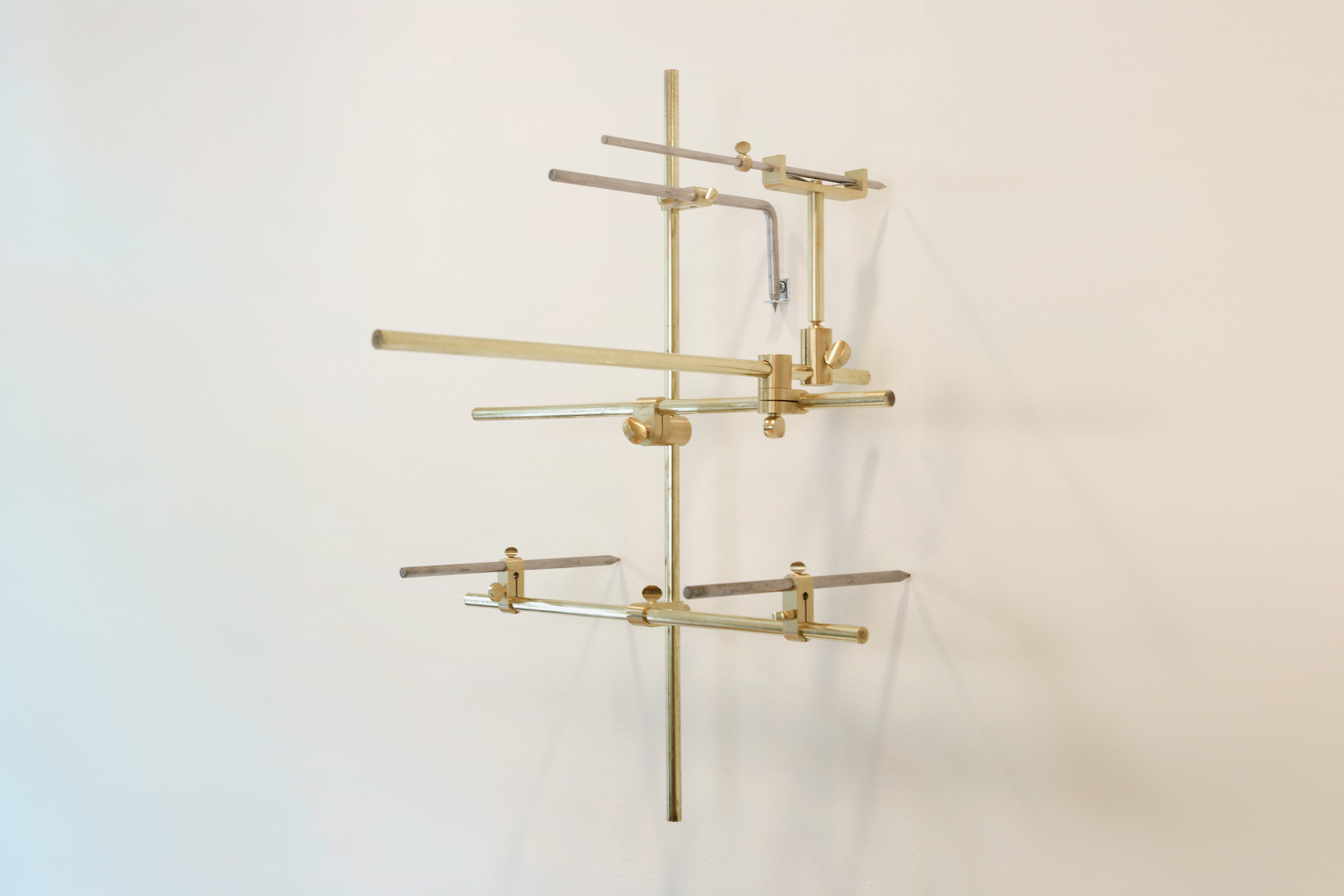
1. Pointing Machine (Macchinetta di Punta)
Cooper Campbell
With assistance from Richard Zeeme
After John Bacon the Elder RA, Antonio Canova, Nicholas-
Marie Gatteaux
Late 18th Century/2018-2020
Brass, steel
Dimensions variable, est. 24”, 18”, 12
Price extrapolated from labor hours.
By the late eighteenth century the classic sculptor of high fame, whose mind must necessarily be engaged upon his designs in clay or wax, employed assistants to give permanence to his oeuvre. Sculptors of this type were so persuaded of their genius that they expressed some condescension towards those craftsmen upon whom they were now dependent.1
A Pointing Machine is a device used to fabricate one-to-one copies of existent sculptures in subtractive materials (stone, wood, plaster, etc). The device describes the three-dimensional form of a work by measuring points along its surface in relation to each other. The ability to precisely measure and transfer three-dimensional forms allowed the sculptor to contract the labor of production to unskilled or less skilled craftsmen. Three primary needles allow a carver to establish a fixed position on the work they wish to copy and the material they wish to copy the work onto. From this fixed position the carver may create exact measurements of the form using a fourth needle seated in a spring loaded saddle at the end of an articulated arm. The sculptor thereby transfers the spatial data of a pre-existing form onto a new block of material to a high degree of precision.
Evidence of the employment of primitive versions of the pointing machine have been observed in Greek and Roman sculptural practice. However, the earliest known example of a modern Pointing Machine was produced by the French Medalist Nicholas-Marie Gatteaux (1751-1832) sometime in the late 1700’s though the English Sculpture and Porcelain manufacturer John Bacon (1740-1799) produced a similar device in the same era that he later gifted to the Italian artist Antonio Canova (1757-1822) who perfected the device and popularized its usage.
1 Ayres, James. “The Pointing Machine.” Art, Artisans and Apprentices: Apprentice Painters & Sculptors in the Early Modern British Tradition, Illustrated, Oxbow Books, 2014, p. 335
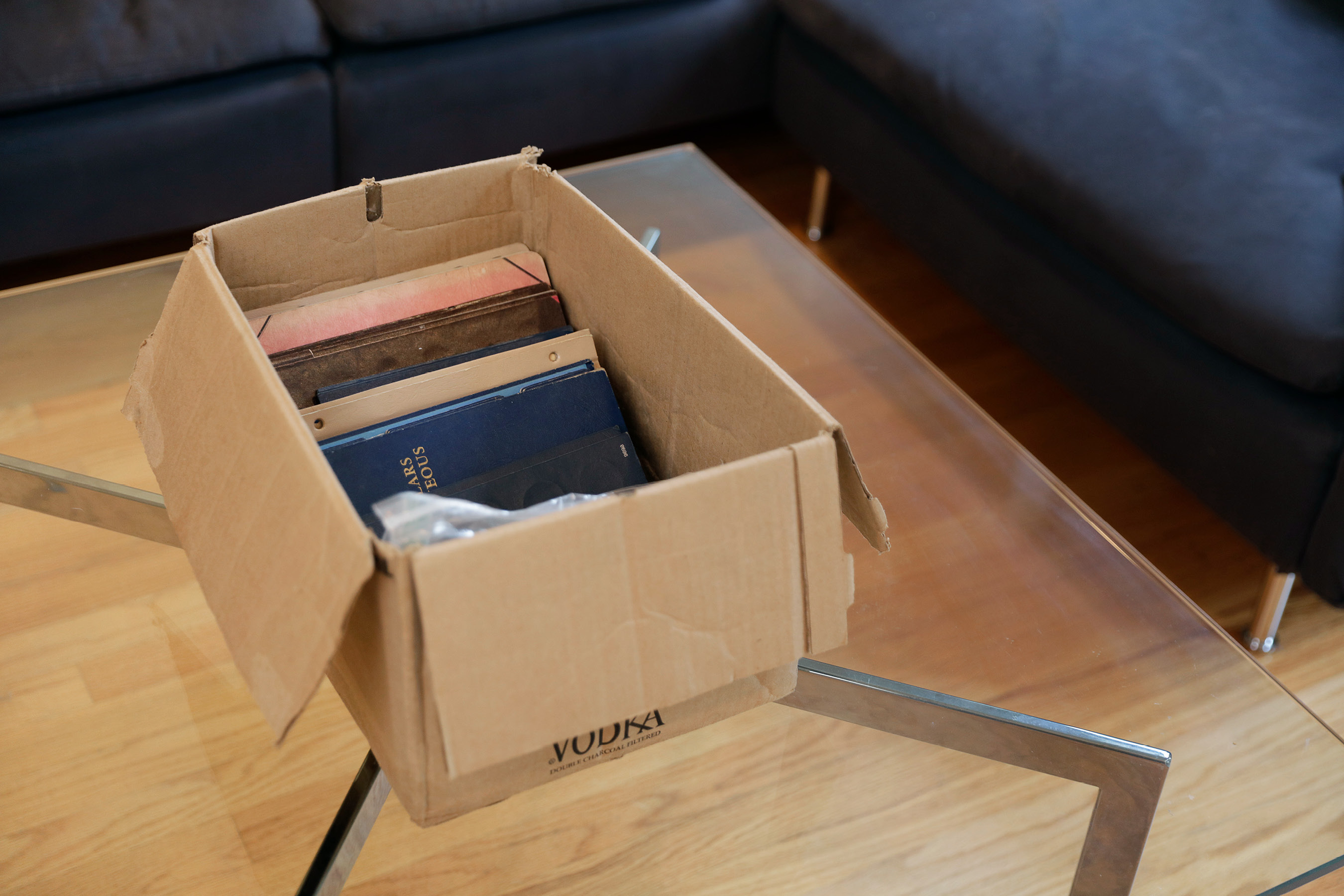
2. American Coinage
Cooper Campbell with Thomas Lunt
1860-1978/2020
Carboard, copper, gold, silver, steel
Dimensions variable
Available for lease with monthly rental cost contingent on
face value, material value (as per COMEX) and numismatic
value (as per Greysheet) appraisals. Contract available upon
request.
“Long before the advent of coinage, ancient civilizations utilized gold and silver in the form of jewelry, art, and ingots. These metals were measured and valued by weight. Sumerian clay tablets reveal that as far back as 2400 B.C.E., official standards existed for the weighing of silver for use as money. The same was true throughout the ancient world. One of the earliest passages in the Old Testament reports that Abraham “weighed to Ephron... four hundred shekels of silver, current money” to buy a burial plot for his wife, Sarah.1
Money in the form of coins first made its appearance in Lydia2 around 640 B.C.E. The first coins were made of a naturally occurring alloy of gold and silver called electrum. A government symbol on each coin attested that it weighed the proper amount. Merchants found these ingot coins more convenient than bringing out the scales to weigh silver in every transaction. About a century later, King Croesus, the most famous Lydian king, decreed that all official coins had to be minted in either refined gold or silver. This manner of coinage persisted for over 2,500 years because of the durability, scarcity, uniformity, and divisibility of these metals. They were a measure of value, an easy way to transfer and preserve wealth, and readily accepted for services and commodities worldwide.“
Foster, Ralph. Fiat Paper Money: The History and Evolution of our Currency. Foster Publishing. Kindle Edition.
There are three primary forms of money. Commodity money has inherent value such as salt, cocoa beans, and tobacco or the exchange of precious metals like gold, silver, and copper. Representative currency functions as a certificate, its value being generated by its function as a guarantee of a predetermined amount of a select commodity. The third form is called fiat currency, money whose value is expressed through social agreement.
The coins in American Coinage are all examples of partially representative money, these coins (save for a limited pressing of steel pennies issued during a copper scarcity caused by WWII) are all partial commodity tokens. The face value or intended value of the coins is divorced from their material commodity value via the decoupling of US’s dollar from the gold standard. Additionally the influence of perceived scarcity has distorted the value of these coins, creating a third form of numismatic value or collectability. There is no static value for these coins due to the fluctuations of the value of the dollar, the precious metals markets, and the numismatic markets. All continually reappraise the value of these coins.
1 Genesis 23:16. The shekel was a hebrew unit of weight.
2 An ancient Kingdom located in what is now Turkey

3. Surmoulage
Cooper Campbell, with assistance from Firebird Bronze
Foundry, Portland OR.
After Auguste Rodin with Rudier Foundry, Sculptures LTD.
1897, 1965-1975 (approx), 2020
Bronze
12 x 6 x 8 inches
Editon of 12 with 2 Artist’s Proofs
Price contingent on market rate.
The work is a surmoulage1 of Rodin’s Definitive Study for the Head of Balzac, (1897). Surmoulage is reproduced from a resin edition produced by Sculptures LTD a company that specialized in low cost resin editions of minor works by canonical Western artists.
This casting is not a true edition. Despite the casting having Rodin’s signature as well as the foundry mark from the artist’s lifetime foundry2, leaving the sprue system attached and the bronze un-patinated disallows the intended authorship of Rodin while still retaining the form of the intended work.3
The original work Definitive Study for the Head of Balzac, (1897) by Auguste Rodin is a study for the Monument to Balzac (1891–1897), a public commission from Société des Gens de Lettres de France. Following the initial display in 1898 at the Salon at Champ de Mars, the work was rejected by the Société and the plaster was moved to Rodin’s studio at Meudon where it was displayed for the next forty years before being editioned in bronze in 1939, twenty-two years after the artist’s death.
Often referred to as the first modern sculpture, monumental bronze castings can be found in the collections of The Norton Simon Museum of Art (Pasadena, California, U.S.), the Hirshhorn Museum Sculpture Garden (Washington D.C, U.S.), the Museum of Modern Art in (New York City, New York, U.S.), the Los Angeles County Museum of Art, (Los Angeles, California, U.S.), the Middelheim Open Air Sculpture Museum (Antwerp, Belgium), the Musée Rodin (Meudon, France), the Van Abbemuseum (Eindhoven, Netherlands), Hakone Open-Air Museum (Ashigarashimo District, Kanagawa Prefecture, Japan), the National Gallery of Victoria in (Melbourne, Australia), and in public installation at the intersection between Boulevard Raspail and Boulevard du Montparnasse, (Paris, France) as well as in the open spaces around the former Ateneo de Caracas (Caracas, Venezuela). Evidence suggests two additional castings; one somewhere in the U.S. and another in Europe.
Bronze editions of Definitive Study for the Head of Balzac (1897) were initially cast by Georges Rudier nearly fifty years after Rodin’s death, from the plaster studies made in preparation for the monument and left behind in the artist’s studio. The study can be found at the Musée Rodin (Meudon, France) with editions found in the collections of Cleveland Museum of Art (Cleveland, Ohio, U.S.), Baltimore Museum of Art (Boston, Massachusetts, U.S.), Chrysler Museum of Art (Norfolk, Virgina, U.S.), Legion of Honor (San Francisco, California, U.S.), Mount Holyoke College Art Museum, (South Hadley, Massachusetts, U.S.), The Hirschorn, (Washington, D.C., U.S.), The Kreeger Museum (Washington, D.C., U.S., two copies in the National Gallery of Art (Washington, D.C., U.S.), Maryhill Museum of Art (Goldendale, Oregon, U.S.), the Brooklyn Museum (New York City, New York, U.S.), McMullen Museum of Art at Boston College (Boston, Massachusetts, U.S.), The Museum of Modern Art, (New York City, New York, U.S.) as well as a plaster at the Nasher Sculpture Center (Dallas, Texas, U.S.).
1 An unauthorized cast of an original authorized casting.
2 Alexis Rudier
3 This is to protect Campbell from encroachments of Rodin’s authorship.
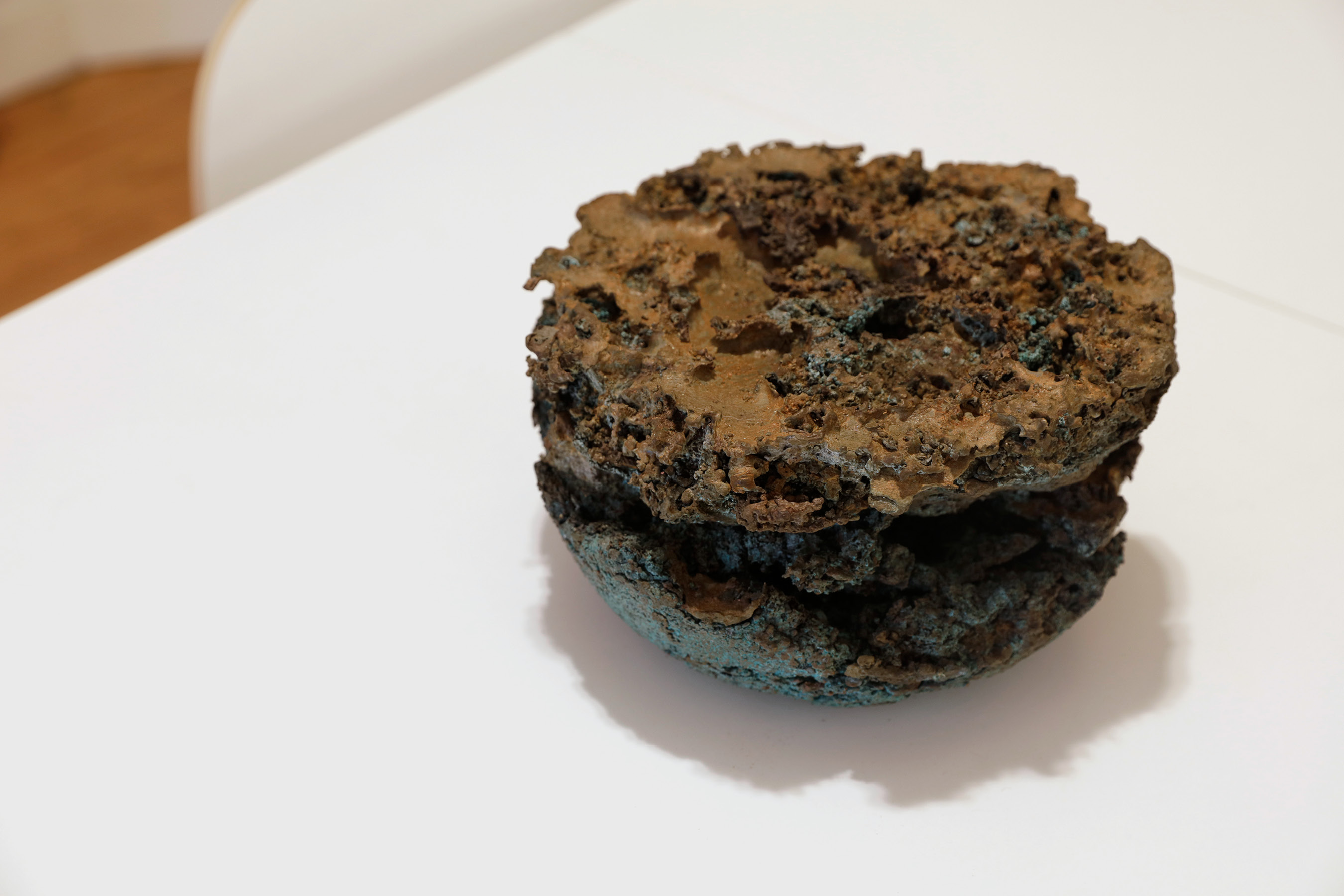
4. Dross
Cooper Campbell
2020
Bronze, Unknown Heavy Metals
9”, 9”, 6”
Price contingent on copper spot price appraisal (as per
COMEX).
Dross is the term for material impurities of a given alloy or metal that has formed on the surface of liquid metal during the casting process. They are primarily oxides that are produced by the extreme heat necessary for the casting process—as well as tertiary contaminants that may exist in the casting stock.
Dross is absolute waste. Due to its unreliable and unknown make up it is unusable in any continued casting process and unrecyclable as a byproduct. The work is a concretion of this cast off and waste materials bound into a consolidated mass by a matrix of bronze.

5. Consignment; Ormolu and Blue Glass Centerpiece with
Floral Arrangement
Louis Constant Sévin for the Barbedienne Foundry, Cooper
Campbell, Consigned by Colin Ross, Flowers from Saffron;
Arranged by Grayson Scott
1880, 2021
Cobalt Glass, Ormolu Bronze (Gold), Flowers
Ormolu and Blue Glass Centerpiece available via M&M
Gallery. Foral Arrangment COA available via Colin Ross with
proof of purchase of Ormolu and Blue Glass Centerpiece.
Price contingent on market rate.
An ormolu bronze vase1, decorated with medallions of putti and trophies of musical instruments lined with cobalt blue glass, designed by Louis Constant Sévin2 for the Barbedienne Foundry3, cast 1880, Paris. Consigned to gallery eyes never sleep, LLC from the New York City antiques dealer M&M Gallery for the exhibition. The vase features a bouquet of primarily French flora: White Gentian, Chamomile, Heather, Paper Reed and various American Grasses arranged by florist Grayson Scott. The bouquet will remain in the vase for the duration of the consignment.
1 A type of gilding, hi-karat gold is dissolved in mercury and applied to a bronze substrate, the piece is then fired in a kiln driving off the mercury leaving a gold coating. Ormolu gilders rarely lived past thirty.
2 Louis-Constant Sévin (1821-1888) A well known french ornamentalist, works can be found in the Metropolitan Museum of Art, Carnegie Museum, Musée d’Orsay, amongst others. Officer of the French Legion of Honor.
3 Ferdinand Barbedienne (1810-1892) A french Founder and industrialist, credited with creating one of the largest industrial art production monopolies in modern history.
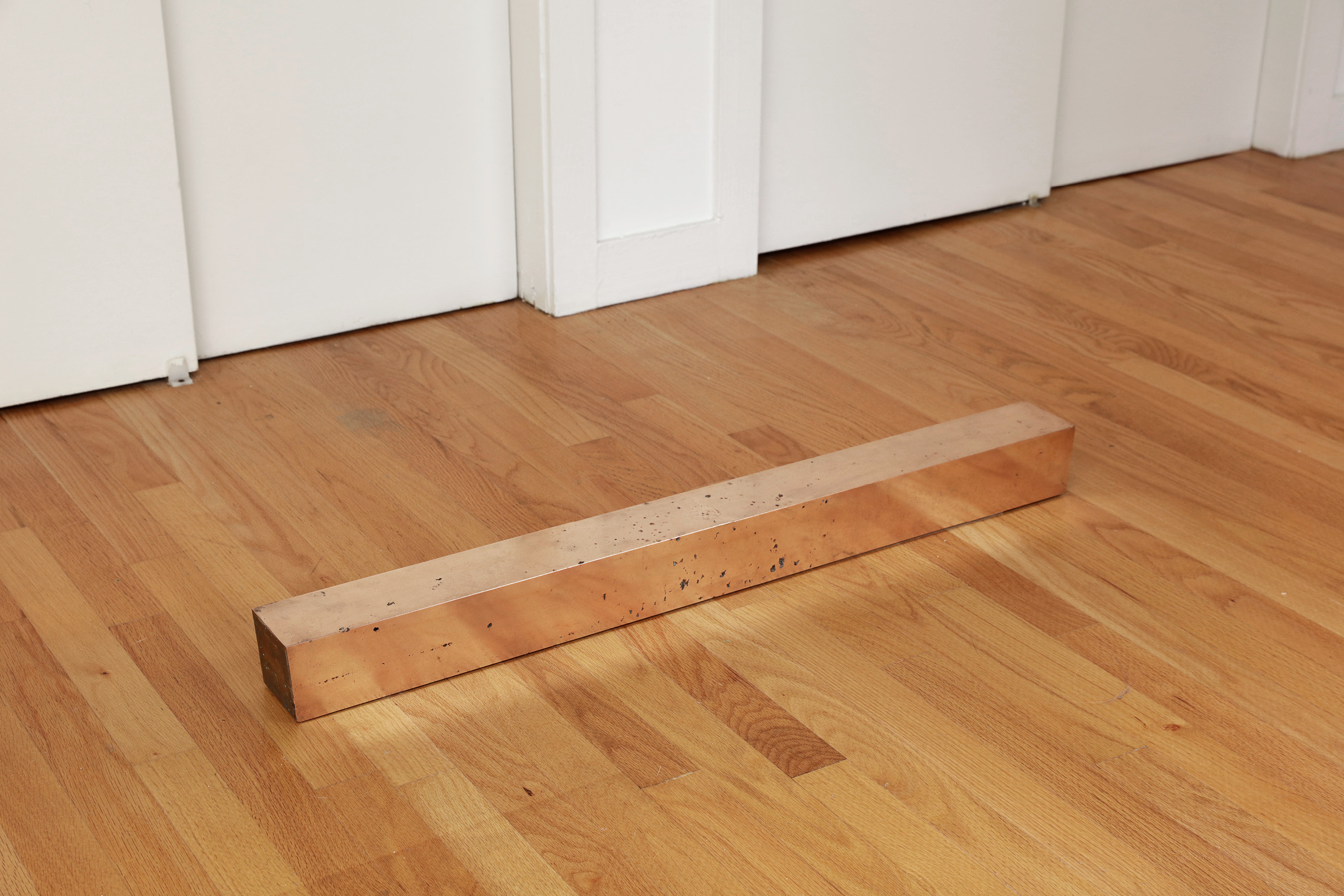
6. Billet (Copper)
Cooper Campbell with assistance from Michale Carbone and
Ha-Lan Van
2020
Copper
3”, 3”, 34”
Available by lease with monthly rental cost contingent on
copper spot price appraisal (as per COMEX).
Copper can first observed in the material record of humanity roughly 8,700 BCE the first known example of human manipulation of this metal (or any metal) being a small pendant found in what is now Northern Iraq1 that appears to be hammered out of “native copper” or naturally occurring deposits of relatively pure copper metal.
Additional examples of decorative objects wrought from native copper have been found in Cyprus, Northern Iran2 and Michigan’s Upper Peninsula3 both dating back to roughly 7000 BCE. Over the course of the intervening millenia Copper has been one of the most instrumental materials in human technological advancement; first used as decorative objects (Like the Iraqi pendant) that dually functioned as currency, copper was quickly utilized in tooling before being retasked during the industrial revolution as electrical wiring–its ductility and conductivity allowing for the electrification of modern society. Cast from both industrial and domestic scrap material (electrical wiring, plumbing line and fittings, electric motor windings, computer parts, decorative figurines, american pennies, etc) purchased from Steve Cook at spot price per pound the material present in Billet (Copper) was cleaned and partially refined before being cast and machined down a billet weighing exactly one-hundred pounds.
1 Radetzki, Marian. “Seven Thousand Years in the Service of Humanity—the History of Copper, the Red Metal.” Resources Policy, vol. 34, no. 4, 2009, pp. 176–84. Crossref, doi:10.1016/j.resourpol.2009.03.003.
2 Ibid.
3 Ibid.